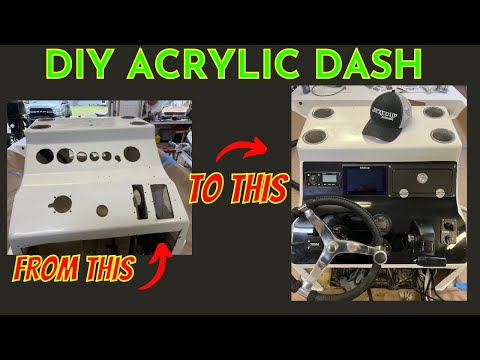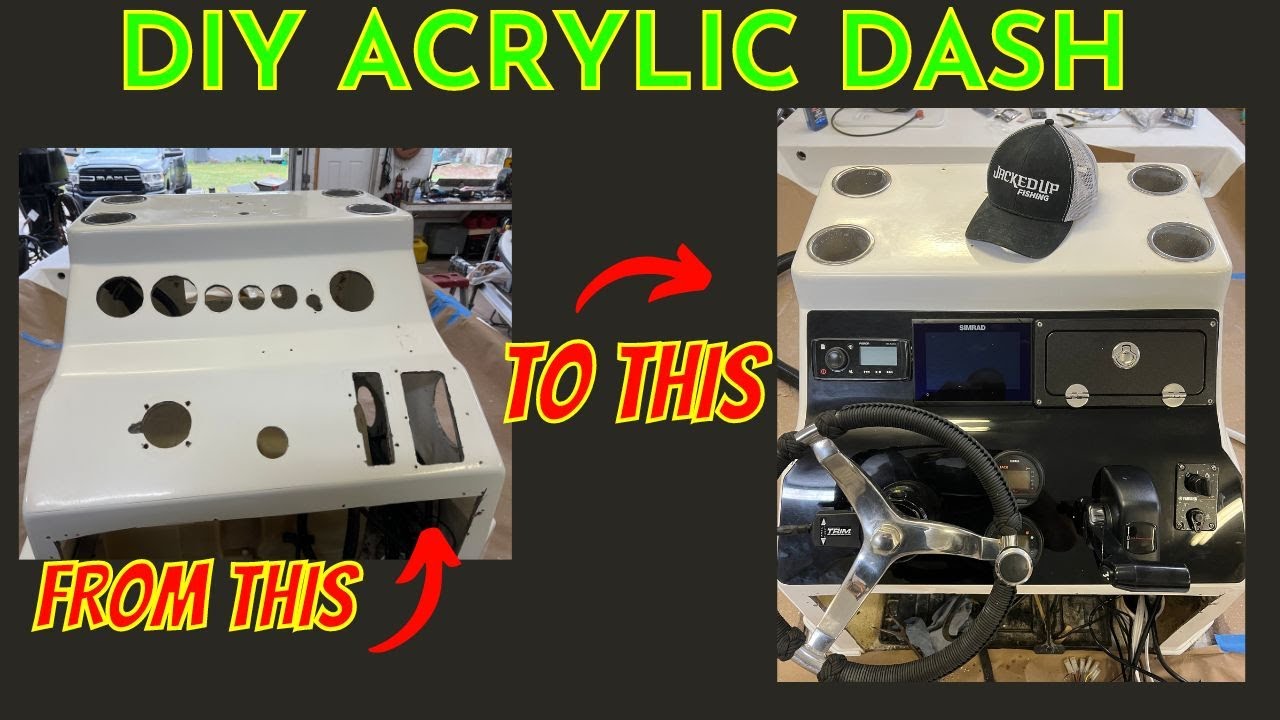Boat dash panel fabrication is the art of designing and manufacturing customized dashboard panels for boats, ensuring optimal functionality and aesthetic appeal. With precision and expertise, skilled fabricators transform raw materials into sleek and durable dash panels that enhance the overall performance and appearance of your vessel. Whether you are a boating enthusiast seeking to upgrade your current boat or a boat manufacturer in need of top-quality dash panels for your new models, this service is tailored to suit your specific needs. Boat dash panel fabrication combines cutting-edge technology and innovative design, resulting in panels that are not only visually striking but also highly functional. These panels can accommodate various instruments and gauges, providing easy access and clear visibility for essential navigation and control systems. Whether you prefer a classic, timeless design or a more modern and sleek look, skilled fabricators can create dash panels that reflect your personal style and taste. Harnessing their expertise in the field, they can offer valuable advice on the best materials and finishes to ensure your dash panel withstands the harsh marine environment. So, if you are looking to upgrade your boat's dash panel or embark on a new boat-building project, boat dash panel fabrication is the perfect solution to elevate your boating experience to new heights.

2023 Trending Boat Dash Panel Fabrication
| Panel Material | Advantages | Disadvantages |
|---|---|---|
| Carbon Fiber | Carbon fiber dash panels are the epitome of modern boat fabrication. They offer exceptional strength-to-weight ratio, ensuring durability without compromising on weight. The sleek and glossy appearance of carbon fiber also adds a touch of luxury to any boat interior. | However, the high cost of carbon fiber materials can be a deterrent for some boat owners. Additionally, carbon fiber panels may require specialized tools and expertise for installation and maintenance. |
| Aluminum | Aluminum dash panels are a popular choice due to their lightweight nature and corrosion resistance. They offer excellent durability, even in harsh marine environments. Additionally, aluminum panels can be easily customized and engraved with various designs and labels. | One drawback of aluminum dash panels is their susceptibility to dents and scratches. Although these can be repaired, it may require professional assistance. Additionally, aluminum panels may not provide the same level of aesthetic appeal as carbon fiber. |
| Wood | Wood dash panels exude a classic and timeless elegance, making them a preferred choice for traditional boat enthusiasts. They offer a warm and rich aesthetic that adds a touch of sophistication to any boat interior. Wood panels can be crafted in various styles, such as teak or mahogany, to suit individual preferences. | Despite their charm, wood dash panels require regular maintenance to prevent warping, fading, or rotting. Exposure to moisture can be particularly damaging. Additionally, wood panels may not possess the same level of durability as carbon fiber or aluminum. |
| Fiberglass | Fiberglass dash panels offer a versatile option that strikes a balance between durability and cost-effectiveness. They provide excellent resistance to water, UV rays, and impact, ensuring a long-lasting solution for boat dash fabrication. Fiberglass panels can also be easily molded into custom shapes and designs. | Compared to carbon fiber or aluminum, fiberglass panels may not offer the same level of strength. They can be prone to cracking or chipping if subjected to heavy impacts. Additionally, fiberglass dash panels may lack the high-end aesthetic appeal of other materials. |
As an expert in boat dash panel fabrication, it is essential to stay up-to-date with the latest trends. In 2023, we see a significant shift towards carbon fiber dash panels, known for their exceptional strength-to-weight ratio and luxurious appearance. Carbon fiber panels offer the perfect combination of durability and style, making them highly sought after by boat owners looking to enhance their vessel's interior.
However, it is important to note that carbon fiber materials come with a higher price tag and require specialized tools and expertise for installation and maintenance. This might deter some boat owners who are more budget-conscious or lack the necessary resources.
For those seeking a lightweight and corrosion-resistant option, aluminum dash panels remain a popular choice. The durability of aluminum, combined with its ease of customization and engraving, makes it a versatile option for boat dash fabrication. However, aluminum panels are susceptible to dents and scratches, which might require professional repair. Additionally, some boat owners might prefer the sleek and glossy appearance of carbon fiber over aluminum's aesthetic.
Traditional boat enthusiasts often gravitate towards wood dash panels, which exude a classic and timeless elegance. Wood panels offer a warm and rich aesthetic that adds sophistication to any boat interior. However, they require regular maintenance to prevent warping, fading, or rotting, especially when exposed to moisture. While wood dash panels possess charm, they may lack the same level of durability as carbon fiber or aluminum.
Finally, fiberglass dash panels provide a versatile and cost-effective option for boat dash fabrication. Their resistance to water, UV rays, and impact ensures a long-lasting solution. Fiberglass panels can be molded into various shapes and designs, offering customization opportunities. However, they may not possess the same level of strength as carbon fiber or aluminum and might be prone to cracking or chipping if subjected to heavy impacts.
In conclusion, when it comes to boat dash panel fabrication in 2023, carbon fiber is trending as the material of choice among boat owners seeking a combination of strength, weight efficiency, and luxury. However, aluminum, wood, and fiberglass panels still have their merits, catering to different preferences and budget considerations. As an expert, it is crucial to understand these trends and guide boat owners towards the most suitable and stylish dash panel options for their vessels.
Creating a Stunning Acrylic Dash for Your Boat with Map Gas & Propane Torches: A Step-by-Step Guide
The Importance of Boat Dash Panel Fabrication
When it comes to boat customization, one area that often gets overlooked is the dash panel. However, the dash panel plays a crucial role in the functionality and aesthetics of a boat. It houses important navigation and control systems, and it is also one of the first things that catches the eye of anyone stepping on board. In this article, we will delve into the world of boat dash panel fabrication, exploring the process, materials used, and the benefits it can bring to your boating experience.
1. Understanding the Fabrication Process
The process of boat dash panel fabrication involves the creation of a custom-made panel that fits seamlessly into the boat's dashboard. This is achieved through a series of steps, starting with the design phase. Experienced fabricators work closely with boat owners to understand their specific needs and requirements, taking into account the type of boat, its purpose, and the desired functionality.
Once the design is finalized, the fabrication process begins. This typically involves cutting and shaping the panel using specialized tools and machinery. The panel may be made from various materials, such as marine grade plywood, fiberglass, or aluminum. The chosen material is then carefully molded and shaped to create the desired design.
After the panel is shaped, it undergoes a finishing process, which includes sanding, painting, or applying a protective coating. This ensures that the panel not only looks aesthetically pleasing but is also durable and resistant to the harsh marine environment.
2. Materials Used in Dash Panel Fabrication
Choosing the right material for your boat dash panel is essential to ensure its longevity and functionality. Here are some commonly used materials in boat dash panel fabrication:
Marine Grade Plywood: This type of plywood is specifically designed for marine applications. It is resistant to water, rot, and insects, making it an excellent choice for boat dash panels.
Fiberglass: Fiberglass is a versatile material that is lightweight, strong, and durable. It can be molded into various shapes and sizes, making it ideal for creating custom dash panels.
Aluminum: Aluminum is known for its strength, corrosion resistance, and lightweight properties. It is commonly used in high-performance boats or those exposed to extreme conditions.
Each material has its own advantages and considerations, so it's important to consult with a professional fabricator to determine the best choice for your boat.
3. The Benefits of Custom Dash Panels
Investing in a custom dash panel for your boat can bring numerous benefits that enhance your boating experience. Here are some key advantages:
Enhanced Functionality: Custom dash panels allow you to have all the necessary controls and instrumentation at your fingertips. You can design the layout to suit your specific needs, ensuring easy access and efficient operation.
Improved Aesthetics: A custom dash panel adds a touch of personalized style to your boat. You can choose from a wide range of finishes, colors, and designs to match your boat's overall look and feel.
Increased Resale Value: A well-designed and professionally fabricated dash panel can significantly enhance the value of your boat. Potential buyers will appreciate the attention to detail and functional improvements.
4. Choosing a Professional Fabricator
When it comes to boat dash panel fabrication, it is crucial to choose a professional fabricator with experience and expertise in the field. Look for a fabricator who has a proven track record and a portfolio of successful projects. It's also important to communicate your needs clearly and ensure that they understand your vision for the dash panel.
Ask for recommendations from fellow boaters or do some research online to find reputable fabricators in your area. It's worth investing in quality craftsmanship to ensure that your dash panel meets your expectations and stands the test of time.
5. Maintaining Your Dash Panel
Once your custom dash panel is installed, it's important to properly maintain it to prolong its lifespan. Here are some tips to keep in mind:
Regular Cleaning: Wipe down the dash panel regularly with a mild detergent and water to remove any dirt or debris. Avoid using abrasive cleaners that could damage the panel's finish.
Protective Coating: Consider applying a protective coating to your dash panel to shield it from UV rays, saltwater, and other environmental elements. This will help prevent fading, cracking, or discoloration.
Inspection: Periodically inspect the dash panel for any signs of damage or wear. Address any issues promptly to prevent further damage or potential safety hazards.
In conclusion, boat dash panel fabrication is a crucial aspect of boat customization that should not be overlooked. With the right design, materials, and professional fabricator, you can enhance the functionality, aesthetics, and value of your boat. So, why settle for a standard dash panel when you can have a custom-made one that perfectly suits your needs and style?
Boat Dash Panel Fabrication
- Designing the layout and functionality of the dash panel
- Choosing the appropriate materials for the panel, such as marine-grade plywood or fiberglass
- Measuring and cutting the panel to the desired dimensions
- Creating cutouts and holes for gauges, switches, and other components
- Sanding and smoothing the edges of the panel
- Applying a protective coating, such as marine-grade varnish or gel coat
- Installing electrical components and wiring
- Mounting the dash panel securely onto the boat
- Testing the functionality of the panel and making any necessary adjustments
- Ensuring a clean and professional finish for the panel

